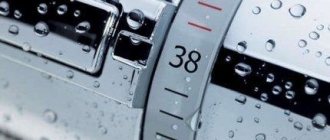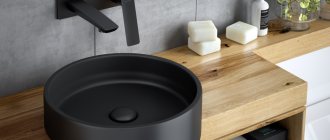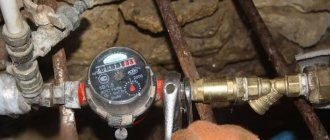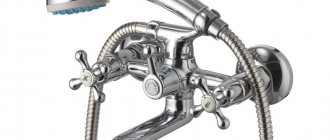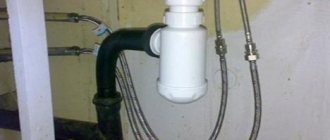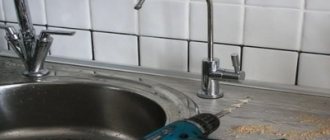A kitchen and bathroom faucet should be convenient and reliable, and its use should be practical and safe. An article about the principles of operation and operation, as well as how to install a thermostatic mixer. The kitchen and bathroom are intended primarily to use water - for cooking, for washing and washing, for all household needs and concerns. The entire plumbing system is tied to the main thing - the water supply tap, which in turn is part of the mixer, a device whose task is to comfortably mix hot and cold water. Why is such a faucet appropriate for a bathroom and how to install it correctly and reliably?
Thermostatic mixer in the kitchen
Thermostatic, unlike a conventional mixer, not only performs the functions of determining the pressure and mixing hot and cold water, but also controls the strength of this pressure and the set temperature.
Thermostatic mixer and its operating principle
The operation of the thermostat is based on simple mechanics: a thermoelement is installed inside the mixer - a movable limiter that reacts to changes in the set temperature.
This movable limiter is a plastic cylinder with a copper tip and a paraffin base (sometimes a base of wax or other similar material that can instantly expand under elevated temperatures). A plastic sleeve-limiter is located inside a special cartridge in a metal pipe into which hot and cold water flows.
When higher temperature water enters, the paraffin expands and moves the plastic cylinder into the cartridge, reducing the space for hot water while increasing the space for cold water.
Thermostatic mixer design diagram
At temperatures above 58C, the thermoelement completely shuts off the flow of water to prevent serious burns.
The adjustment occurs instantly and in both directions, adapting to water flows: lowering the temperature of hot water will reduce the amount of cold water, again when the position of the cartridge changes: the cooled paraffin will move the plastic limiter so that hot water flows in greater quantities.
There is a mixer with a thermostat that regulates not only the temperature, but also the pressure, controlling the strength of the incoming stream, based on approximately the same mechanical principle: increasing pressure means less space in the cartridge for water to flow, decreasing pressure means more space.
The thermostatic mixer is safe for all members of your family
Thermostat mixer – to take or not to take?
A thermostat or thermostatic mixer is a mixer that is capable of maintaining a constant, predetermined water temperature and outlet flow. This is very important when there are constant changes in pressure or temperature of water in your water supply, especially hot water. In addition to external reasons for changes in pressure, there may also be internal ones, for example, if at the moment when you take a shower, the dishwasher or washing machine turns on, or someone presses the flush button in the toilet.
An ordinary faucet lacks these qualities; it is not able to maintain a constant temperature and constant water pressure. If there are any changes in your water supply, you will definitely feel it yourself.
Design and operation scheme
To control the thermostatic mixer, two handles are used; the first one turns on the water and regulates its pressure. Using the second, the temperature of the water coming out of the tap is set.
The function of maintaining a constant water temperature in the mixer is performed by a thermostatic cartridge. It consists of a body, a metal cylinder with holes, a plastic cylinder and a thermostat (valve), the thermostat in turn consists of a copper rod and a flask with paraffin.
When the faucet is turned on, hot and cold water begins to flow to the thermostatic cartridge. Depending on the temperature of the mixed water, the wax in the flask expands or contracts, thereby moving the valve and regulating the flow of incoming cold water. For example, if the water gets hotter, the paraffin expands and moves the valve back so that it allows more cold water to pass through, thus bringing the water temperature back to its original temperature. If the temperature of the leaving water decreases, the valve begins to let in less cold water and also equalizes the temperature.
Thus, this device manages to maintain a constant outlet temperature.
Recommendations for installation and operation
In order for the mixer you installed to serve you for a long time, you need to adhere to certain rules:
- The operating water pressure must be in the range from 1 to 5 bar, the maximum allowable is 8 bar;
- The difference between the pressure of cold and hot water should not exceed 10%;
- For the thermostat to work properly, it is necessary to install a reduction reducer if the water pressure exceeds 5 bar or the pressure difference between cold and hot water is more than 10%. Install a filter with a cell size of no more than 315 microns;
- The hot water supply is usually on the left when looking at the thermostat. On some models the opposite may be true. Therefore, you should select a thermostat for installation in advance and supply water in accordance with the attached instructions.
Check the filters regularly because if they become clogged, you will not have the required pressure in the mixer and you will not be able to use it. It is also not recommended to use it while the water supply is being repaired; at this moment, a water hammer may occur, which will damage your device.
Malfunctions
The most important malfunction of a mixer with a thermostat is the failure of the cartridge. The reason for this is usually bad water. Microparticles of pipes, scale and impurities clog the cartridge mesh, and it stops working in the required modes. As mentioned above, a filter will help you with this; if it is not possible to install it, it is recommended from time to time to clean the mesh at the mixer inlets, which it is equipped with at the factory, and which becomes clogged with impurities from the water.
Connection to a gas boiler
Many buyers are interested in the question: is it possible to install a mixer with a thermostat on a water supply system in which the water is heated by a gas boiler? This issue is especially relevant in private country houses and cottages, where there is no central water supply and you have to independently install a water supply system.
The answer to this question is very simple, see the section of the article with operating recommendations. If your water pressure at the boiler outlet is in the range from 1 to 5 bar and the difference between the pressure of cold and hot water is no more than 10%, then in this case you can safely install a thermostatic mixer, otherwise you won’t have one. will work and you will have to think about how to make sure that the water characteristics meet the specified requirements.
Pros and cons of a thermostatic mixer
The advantages of a mixer with a thermostat are obvious - ease of use and safety. Set the desired temperature once, and then just open and close the water. The second advantage is protection against burns, it manifests itself in two cases: firstly, when you take a shower and the water temperature in the network rises sharply or the cold water pressure drops, the thermostat either instantly equalizes the temperature or turns off the water altogether. Secondly, there is a limiter installed on the temperature control handle. It prevents you from accidentally turning on too hot water during or just before your shower. All these advantages are especially noticeable when there are children, elderly people or people with disabilities in the family.
Features and functions of electronic models
A bathroom faucet with an electronic thermostat is a more expensive and technically complex model that requires batteries or an AC adapter. The choice of temperature and water pressure is based on electronic temperature and pressure sensors, which not only regulate the water supply automatically, but also display the indicators on special screens. Such devices can have push-button, touch, or remote control. But in domestic conditions, such equipment is unnecessary and is more often used in medical institutions, public restrooms, swimming pools or saunas.
Mixer with electronic thermostat
Minuses
- Installation feature . The hot water outlet must be on the left, as required by Euro standards. In older houses, the arrangement of water supply pipes is different, which often has to be changed if specified in the operating instructions. Otherwise, the sensor in wall-mounted models will not function correctly or may break.
- Work when the water is turned off in one of the pipelines. The water supply from the other one also stops automatically. Although there are models that have a special switch for opening the valve manually. Then you can use the existing liquid.
- Requirement of power supply . Electronic thermostats are powered by a battery, which needs to be changed periodically, or from the mains via an AC adapter.
- High purchase cost compared to a traditional faucet. But it pays off during operation.
- Manual setting of parameters in mechanical varieties. It takes a little longer, but such equipment is simpler and cheaper than its electronic counterparts.
The design of electronic models is more complex than that of their mechanical counterparts. The complexity requires skill in installation and repair, which will require calling a qualified specialist and high costs. But such plumbing looks more modern and displays additional parameters on the screen.
Advantages and disadvantages of a thermostatic mixer
In the kitchen, this mixer is not always appropriate and convenient. This is due to the frequent need to use only cold water for cooking or other needs. In such cases, the problem is solved by installing a special tap for drinking water with a filter.
A bathroom faucet with a thermostat is a convenient, necessary thing and has no drawbacks from a technical point of view. The main disadvantages are the higher price and possible additional hassle during installation. However, they are more than offset by the advantages and disadvantages:
- safety: any likelihood of any unpleasant sensations when taking a shower, and most importantly, burns, is eliminated. This is important in a house where old people and children live. This is convenient when arranging showers and cramped bathtubs, when even jumping away from the hot jet will not be possible.
- efficiency: the mechanism does not need to be adjusted each time, passing streams of water until the desired pressure and temperature are found. In addition, the device is initially configured for water saving mode.
- convenience and comfort: one click on the lever turns the water on and off. There is no need to use two hands, which is important when washing yourself, and when caring for children, and when performing any other multifunctional actions in the bathroom.
Thermostatic electronic mixer with touch sensors
comparison table
As for the main distinguishing characteristics, this is the presence of S-shaped eccentrics, which are not available in every model, as well as filters. But when choosing, you should also focus on the length of the spout. It is this that will determine the ease of use and the possibility of installing the mixer over the bathtub or in the shower.
| Model | Spout length, mm | Average price, rub. |
| Lemark Yeti LM7832C | 175 | 12 000 |
| Oras Nova 7462U | 160 | 13 000 |
| WasserKRAFT Berkel 4811 Thermo | 174 | 14 000 |
| Grohe Grohtherm 1000 34155003 | 173 | 13 500 |
| Hansgrohe Ecostat Universal 13123000 | 194 | 18 000 |
| KLUDI Zenta 35101 0538 | 187 | 18 000 |
| AM.PM F7550000 | 183 | 16 000 |
General questions about installing a thermostatic standard mixer
Thermal mixer models differ significantly in installation features and purpose. Faucets are available for hidden and open installation. In addition, there are models for showers, bidets, sinks, and kitchens.
Since there is no universal model of a mixer with a thermostat, there cannot be an exact algorithm for installing it. However, there is a need to describe the main difficulties and nuances of installing concealed and open-mounted thermal mixers in the bathroom.
Installation diagram of a standard open-mounted thermostatic mixer
One of the main points is the correct connection to the hot and cold water system. Faucets with a thermostat use the European system of plumbing standards, which does not correspond to the domestic one. Russian water supply systems are designed according to the principle: cold water on the left, hot water on the right. Therefore, when installing a mixer with a thermostat, most likely, the pipes - the entry points of hot and cold water - will have to be swapped.
Important! The choice of model and installation of the water supply must be done before the installation of the mixer with a thermostat begins.
The second note concerns the initial setting of water temperature - calibration. The thermostat is initially set to a neutral position at a temperature of 38C, but it needs to be fixed using a thermometer and a regulator.
Advice. To calibrate, you need to remove the protective cover of the mixer, turn on the water and, by rotating the special valve of the mixer, set the desired temperature, based on the data of an ordinary thermometer.
Faucets with thermostat for shower or bath/shower
An open-mount thermostat mixer for bathtubs and showers is a small metal cylinder that connects to the hot and cold water pipes and then feeds the hose and shower head.
Concealed thermostatic mixer
A device like this is the simplest mechanism to connect. In modern apartments it can be installed most easily.
Important! The distance between the hot and cold water pipes for the mixer is universal, so there are all possibilities for installation. All that remains is to check the relationship between the supply of cold and hot water in the thermostat and the plumbing system.
Models of this series are presented in two options:
- faucet with bath spout and shower head and hose,
- faucet with shower head and shower hose, without bath spout.
- A closed-system thermostat mixer for bathtubs and showers is a more complex device in terms of installation: it will require the installation of some parts into the wall or false walls made of plasterboard. In this case, only a small plate with one or two regulators for turning on and switching water will remain on the bathroom wall.
Important! The absence of external parts is both an advantage and a disadvantage of the model: the design looks laconic, space is used economically, however, in case of repair or replacement of parts, dismantling the wall and tiles cannot be avoided.
The water outlet in such models can be presented in several options:
- upper shower spout with nozzle, which is mounted in the ceiling,
- upper shower spout with nozzle, which is mounted in the ceiling, flexible hose and shower head,
- an upper shower spout with a nozzle that is mounted in the ceiling, and a spout (gander) for the bathtub.
Devices of this kind can also be sold separately: a thermostatic mixer for a closed installation system will require careful selection of the remaining elements: a hose, a shower head and spout, and a bath spout.
How to install a faucet in the bathroom?
You can do the installation yourself, but it is important to follow several important rules and recommendations:
- Hot water connection is on the left, and cold water supply is on the right.
- Calibrate the thermostat according to the temperature of the water in the hot water supply system.
- Installation of an open type mixer on the wall, and a closed type in the wall, which will require gating and creation of a special plasterboard box. In the latter case, repairs will require dismantling the wall or frame.
- It is necessary to regularly change the filter plates to prevent the system from becoming clogged.
Sink and kitchen faucets
Such mixers are not so common, since the need for them is small. These are often models of an open mounting system that are installed directly on the sink and have one lever for turning on the water and a spout.
Models for the kitchen differ in design and specific spout - a more curved gooseneck, but the principle of their operation is no different.
Thermostatic basin mixer
A bathroom faucet with a thermostat has a lot of advantages and is becoming one of the necessary plumbing devices in modern homes, but its installation and installation require certain skills, a special space in the bathroom and excellent knowledge of the principles of the plumbing system and the mechanism itself.
Main selection criteria
A huge assortment of faucets with thermostats creates a lot of problems for the unprepared buyer. After all, choosing the optimal model from this variety is quite difficult and it can take more than one hour.
What to look for before buying?
To find a device that will allow you to shower comfortably, will last at least several years and will not stand out too much in the bathroom design, you need to pay attention to a number of parameters.
Important characteristics:
- material used to make the case;
- valve type;
- presence of a fuse;
- connection method;
- minimum possible working pressure;
- manufacturer.
Before going to the store, it is recommended to familiarize yourself with the products of online stores. This decision will allow you to decide in advance on the optimal model for your bathroom.
Case material
The service life of the mixer largely depends on the reliability of the housing. Accordingly, this factor must be given attention first.
The most reliable and, accordingly, expensive materials are considered to be brass, bronze, and copper. If the appearance of the faucet comes first, and not its strength, then you can give preference to a ceramic product.
Manufacturers also offer models made of plastic and aluminum-silicon alloy (silumin). Yes, these devices are quite cheap, but they will not last very long.
Which valve is better?
An important component of any thermostatic faucet is the valve. This element is often made of ceramic, rubber or leather. The last two materials are used to produce cheap models, which is why many problems arise.
A leather or rubber valve wears out very quickly. This can cause many unpleasant situations in the future. But replacing such a part will not be difficult. The procedure is similar to the process of replacing the gasket in a regular faucet without a thermostat.
Leather and rubber are soft and short-lived materials. It is because of this that quite often a problem arises associated with damage to the valve seat. If solid particles get under the element from the water, the part is damaged, which leads to a flood. Therefore, if you find any problems, you must urgently contact a specialist.
A ceramic valve is more reliable and durable. In this case, a special design prevents debris from getting under the element and, accordingly, the saddle remains intact.
The ceramic valve pushes out all solid particles trapped under it. Moreover, the element has a graphite coating on top, which significantly extends the service life of the mixer.
When operating thermostatic equipment with a ceramic valve, do not use brute force when closing the valve. Failure to comply with this rule will result in the faucet head breaking.
Therefore, to shut off the water flow, you should turn the valve all the way, and the ceramics, precisely adjusted to size, will do the rest.
Why is a safety button needed?
Every more or less well-known manufacturer of thermostatic mixers installs a fuse in their products. This element prevents accidental changes in water temperature. After all, there is always a risk that with one awkward movement you can turn on boiling water and get severe burns.
Most often, the element is made in the form of a button, painted red. In this case, to change the water temperature, you need to release the fuse. This useful feature will be especially relevant for parents with young children.
Mixer connection diagram
When choosing plumbing equipment with a thermostat, it is imperative to ask the seller about the connection diagram for the water pipes to the device. After all, if you connect everything incorrectly, the mixer will break and will need to be repaired, which, as mentioned above, will be quite expensive.
To connect a thermostatic mixer in a bathroom or shower, you can use flexible hoses
Check that the equipment is adapted to Russian standards. Remember that one question will eliminate the need to change the pipe configuration.
Minimum operating pressure
An important characteristic is the presence of sufficient water pressure in an apartment or private house. The vast majority of devices operate at a pressure of 0.5 bar.
If in fact it is lower, the equipment will not function properly. Accordingly, there is simply no point in installing it in your bathroom.
Which manufacturer is better?
The plumbing equipment market is regularly updated with new products. But if you need to purchase a thermostatic mixer of the highest quality, then the best solution would be products from Oras , Jacob Delafon , Grohe , and Hansgrohe .
For the average buyer, products from the Oras . The company always tries to maintain the most favorable balance between product quality and affordability. In production, the company primarily uses plastic or brass.
The cost of thermostatic mixers from Oras is relatively low and amounts to about 180-200 dollars
Since its founding, the French manufacturer Jacob Delafon has established itself as a reliable supplier of brass plumbing equipment. Its distinctive feature is the provision of a five-year warranty on all faucet models.
As for appearance, Jacob Delafon products have a classic design. Equipment costs typically range from $150 to $450.
Grohe boasts the largest range of faucets . This manufacturer offers products equipped with a wide variety of functions and made in various styles.
Grohe uses brass in production. Therefore, it is not surprising that faucets from this brand last at least 10 years.
Although Grohe products differ from their analogues in quality and reliability, they are quite expensive. On average, the price of faucets from this brand is $300-700
Hansgrohe , also deserves respect . Their thermostatic mixers are distinguished by their most laconic design and high durability. Chrome plated steel is used for the manufacture of products.
Hansgrohe faucets are the ideal solution for small bathrooms. After all, the equipment is compact and relatively inexpensive - around $200.
Hansgrohe provides a 5-year warranty on all its products, which is quite good considering the stated price.
Almost all manufacturers offer the buyer several lines of mixers with thermostats. The assortment includes simple models, the design of which focused on their functionality.
But the catalog often includes several products that represent a real work of contemporary art.
Review of popular manufacturers of the best thermal mixers
Popular manufacturers that have proven themselves to be the best in the plumbing fixtures market are the companies Grohe, Jacob Delafon, Oras, Hansgrohe, Lemark, FAR, Varion.
Helpful advice! When choosing a thermostatic mixer, you should pay attention to models designed according to domestic standards, where cold water is supplied to the left and hot water to the right.
The German brand Grohe offers the widest range of products that are distinguished by high quality, reliability and durability. The product catalogs present faucets with Grohe thermostats, which have different designs and a variety of options. The company produces a whole line of uniquely designed devices that are real works of art. The chrome-plated brass body makes the Grohe thermostatic shower mixer hygienic and attractive.
The domestic manufacturer produces high-quality Varion thermostatic mixers, which are characterized by reliability and durability. A distinctive feature of such devices is the use of French-made Vernet cartridges. To create them, high-quality polymer materials are used to ensure efficient, accurate and durable operation of the mixers.
The best faucets today are those with long spouts and showers from the Grohe or Hansgrohe brands.
The French manufacturer Jacob Delafon offers a wide range of high-quality thermostatic mixers, which are made of ceramics. The device body is made of brass. FAR thermostatic mixers offer a good price-quality ratio. Models in the mid-price range are produced by Lemark.
The Oras company offers products at a price accessible to every average buyer. Thermostatic faucets are mainly made from brass and plastic.
The German company Hansgrohe produces thermostatic mixers that are distinguished by their high strength, reliability, durability, affordable cost and laconic design. Chrome plated steel is used to make the case.
The cost of Grohe models ranges from 15 to 45 thousand rubles
